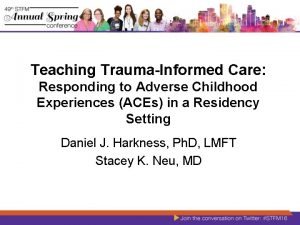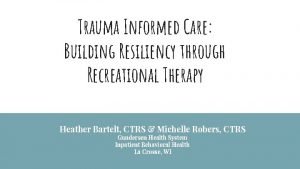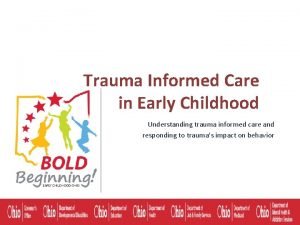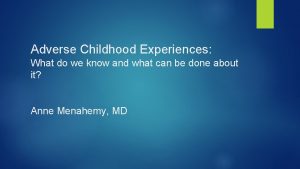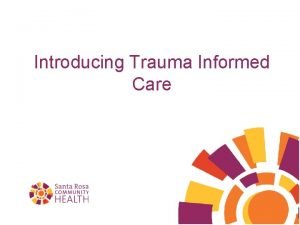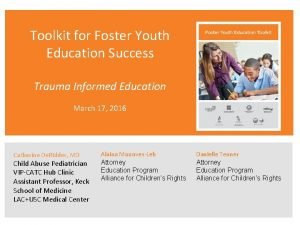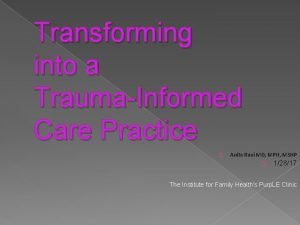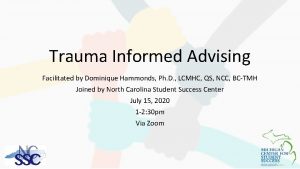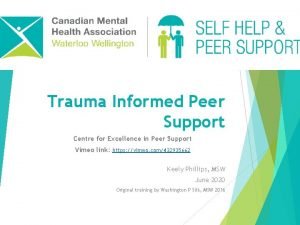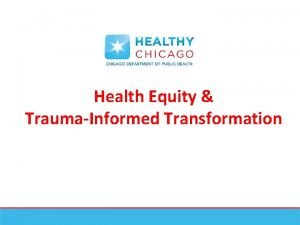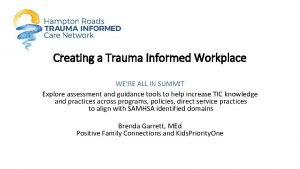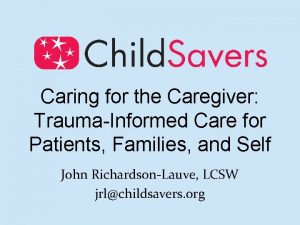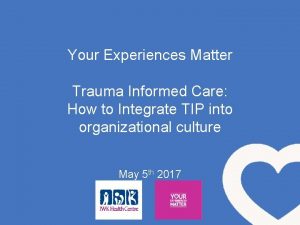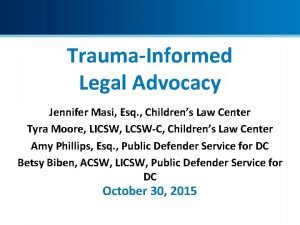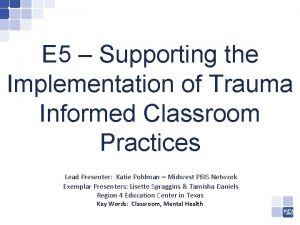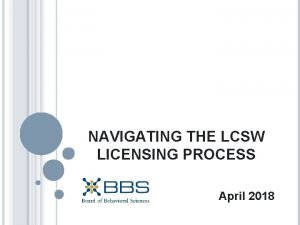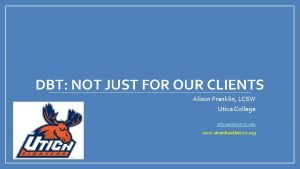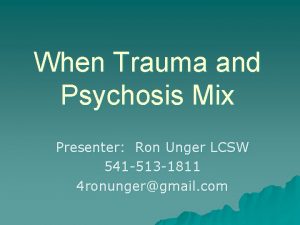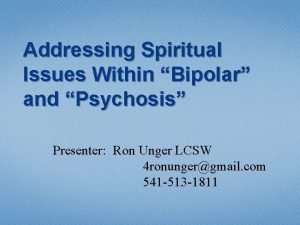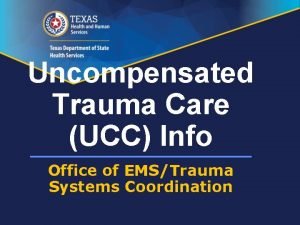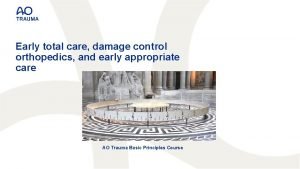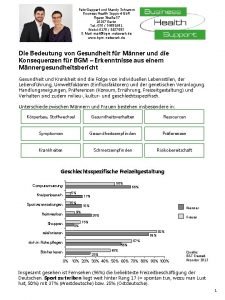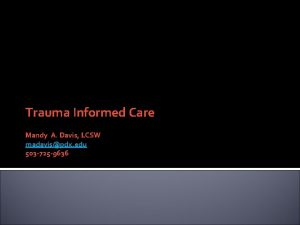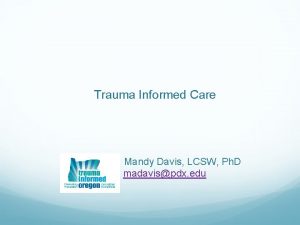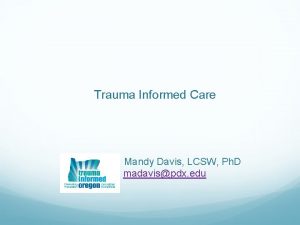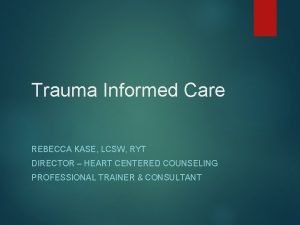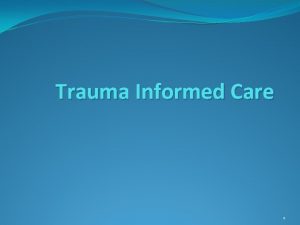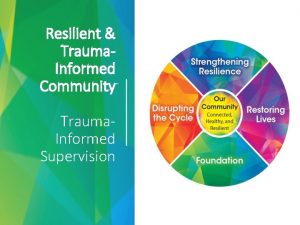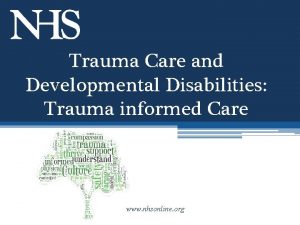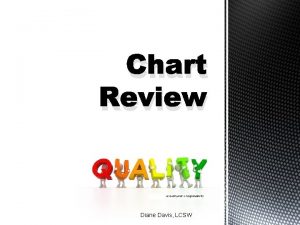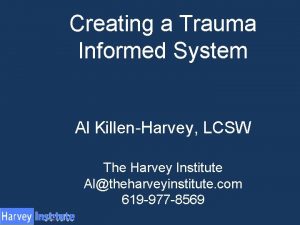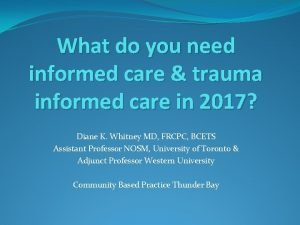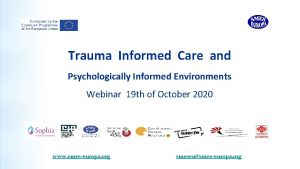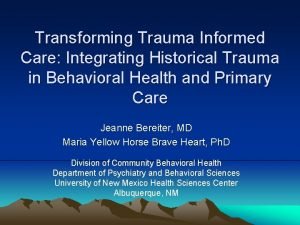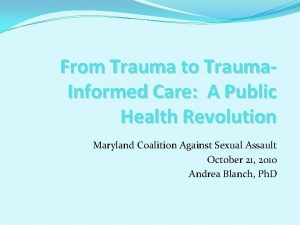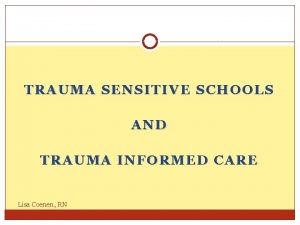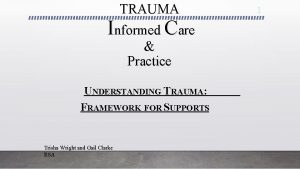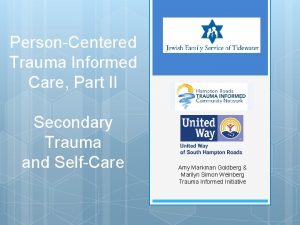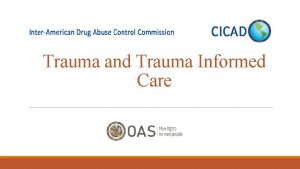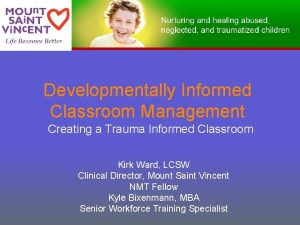Trauma Informed Care Mandy Davis LCSW Ph D
































- Slides: 32

Trauma Informed Care Mandy Davis, LCSW, Ph. D madavis@pdx. edu

Welcoming Attuning What is TIC Application related to Workforce Wellness Organizational resilience

Our Time What Trauma Informed Care is Why it is important NEAR science Application To see how it applies to your work – Are you already doing this? Could this be additive to your work and how?

WHAT IS TRAUMA INFORMED CARE?

Trauma Informed Care Using our understanding of impact of trauma, stress, and adversity to do our work better. “A program, organization, or system that is trauma-informed realizes the widespread impact of trauma and understands potential paths for recovery; recognizes the signs and symptoms of trauma in clients, families, staff, and others involved with the system; and responds by fully integrating knowledge about trauma into policies, procedures, and practices, and seeks to actively resist re-traumatization” (SAMHSA’s Concept of Trauma and guidance for a Trauma-Informed Approach, 2014 http: //store. samhsa. gov/shin/content/SMA 14 -4884. pdf)

What is Trauma? Can be single event. More often multiple events, over time (complex, prolonged trauma). Interpersonal violence or violation, especially at the hands of an authority or trust figure, is especially damaging. Collective, historical, generational Event, Experience, Effect (SAMHA)

Some terms to think about:

Trauma Specific v. Trauma Informed Trauma Recovery/Trauma Specific Services Reduce symptoms Promote healing Teach skills Psycho-empowerment, mind-body, other modalities. Trauma Sensitive Bring an awareness of trauma into view Trauma lens Trauma Informed Care Guide policy, practice, procedure based on understanding of trauma Assumption: every interaction with trauma survivor activates trauma response or does not. Corrective emotional experiences. Parallel process

Why is it important? Trauma is pervasive. Trauma’s impact is broad, deep and lifeshaping. Trauma differentially affects the more vulnerable. Trauma affects how people approach services. The service system has often been activating or re-traumatizing.

What it doesn’t mean It doesn’t mean excusing or permitting/justifying unacceptable behavior Supports accountability, responsibility It doesn’t mean just being nicer Compassionate yes, but not a bit mushy It doesn’t ‘focus on the negative’ Skill-building, empowerment Recognizing strengths

Impact of Trauma What we know ……for now…. . (what everyone needs to know)

The Science Neurobiology Epigenetics Adverse childhood experiences Resilience Laura Porter – Rob Anda

Neurobiology Helps us understand how our brain development and functions are impacted by toxic stress/trauma Challenges with: • • Memory Communication Sensory regulation Executive functioning • Regulation In Survival Mode – assessing threat constantly

Sensory / Perception & Trauma Brain • Connecting to behavior: Do you notice survivors are more aware or bothered by sensory input? Attention & Trauma Brain • Connecting to behavior: Do you notice survivors have a harder time focusing attention? Are they easily distracted? Memory & Trauma Brain • Connecting to behavior: Do survivors forget appointments, treatment plans, what was discussed last time? But, is their memory for threat situations or details good? Executive Function & Trauma Brain Connecting to behavior: Do survivors perseverate, fixate? Do they show problems with impulse control? Struggle with making decisions or planning

Sensory Perception Visual • Least accurate of all senses • Does not reach full adult functioning until age four Auditory • Processing problems have some connection to autism and dyslexia Taste • 2, 000 -5, 000 taste buds • Four types of taste: Olfactory (Smell) § Can detect around 10, 000 smells § 75% of what you taste has to do with smell § Only sensory input that is directly connected to limbic system (memory & emotion) Touch • First of five senses to develop and most prominent at birth • Critical part of growth and nurturing


Epigenetics Helps us understand the impact of toxic stress across generations – transmission through our genetic code

Adverse childhood experiences Links adversities in childhood to adult health http: //www. acesconnection. com/blog/adding-layers-to-the-aces-pyramid-what-doyou-think


Resilience Helps us identify buffering variables that reverse, prevent, or heal this process. https: //www. gannett. cornell. edu/topics/resilience/qualities. cfm

TIC Application

Substance Abuse and Mental Health Services Administration. SAMHSA’s Concept of Trauma and Guidance for a Trauma-Informed Approach. HHS Publication No. (SMA) 14 -4844. Rockville, MD: Substance Abuse and Mental Health Services Administration, 2014. http: //store. samhsa. gov/shin/content/SMA 14 -4884. pdf

WHY and HOW Neurobiology Epigenetics Adverse Childhood Experiences Resilience Safety Transparency & Trustworthiness Peer Support Collaboration Empowerment, Voice & Choice Cultural, Historical, Gender issues To those we are engaging and to our workforce

The Standards for TIC in Schools Agency Commitment Leadership invested in learning Budget for TIC Feedback sought and used Workforce wellness a priority Commitment to equity and diversity Physical Environment and Safety Training Hiring and Onboarding Supervision HR policies and practices Workforce wellness Workforce Development Environmental Scan Staff and consumer experience Safe Space TI crisis protocols in place Service Delivery Welcoming environment Intake process Staff skill set Transparent program rules TSS services available or referred Peer support Systems Change and Monitoring Sustained process for TIC Self-assessment Communication Evaluation, feedback loop

Workforce Wellness Dealing with complexity The brain on scarcity TIC – focus on organization policies that promote

Application CONNECTION Starting with right brain – check in Supervision – peer support SERVICE Volunteer with each other in a different field How can you support a co-worker. SELF-EFFICACY – Confidence and Competence Opportunities and support to learn new ideas Part of a job performance Practice and teach REFLECTION Mindful minutes Innovation time Debriefs or reviews in a TI way PTO and vacation policies

What providers are included? All behavioral health programs licensed by Health Systems (formerly AMH), including: Community Mental Health Programs (CMHPs). Subcontracted providers of CMHPs. Other entities receiving behavioral health funding directly or indirectly through Medicaid or state general funds. Establish a standard to provide treatment in a trauma informed manner. Increase access to effective and appropriate services for individuals who have experienced trauma. Mitigate vicarious traumatization of treatment providers and others working with traumatized individuals.

FRAMEWORK FOR ACTION Systems: Forums: Bend Pendleton La Grande Seaside Eugene Salem Grants Pass Portland (Tri-counties) • Website • Newsletter = 918 • State Forums = 582 • ECE trained in last 6 months = 1, 590 • All Systems trained in 2016 = 4, 813 • Counties we’ve visited = 20 Centralized Resources and Community Building Upcoming Forums: Training and Education Juvenile Justice (probation, detention, court processes) Family, Behavioral, Drug court Faith Communities Home Visiting Programs Head Start Schools & Preschools Ontario Canyon City Corvallis Newport Public Health Implementation and Accountability • Technical Assistance • Research & Evaluation • Standards of Practice Environmental Health Policy and Investment Self sufficiency & Child Welfare • Input from Stakeholders • Initiative Mapping Primary care, NICU, Maternal & child health providers, Occupational health Behavioral Health Systems of Care, Etc

Outcomes of TIC: Generating Buy-In Improved Workforce Wellness Sense of confidence, satisfaction with work Reduced burnout, stress (absenteeism, turnover) Improved organizational climate Increased engagement of those experiences toxic stress Follow through on tasks Adherence to plans or protocols Follow through on recommended referrals Reduced Emergency Room use for healthcare Improved satisfaction with care or services Improved cross-system partnerships

Climate Change Connection We need people to be Include climate change We need groups and local Include in our preparedness Toxic Stress impacts Train up neighbors engaged – organizations to be engaged – engagement Include healing spaces in recovery Include in preparedness behavioral health supports and acute stress response impacts into our ‘why’ in organization and in families Identify policies that are barriers (meds, beds) Advocate for beyond acute response

Resilience to respond and repair Safety Transparency & Trustworthiness Peer Support Collaboration Empowerment, Voice & Choice Cultural, Historical, Gender issues

THANK YOU!
 Reported speech simple past
Reported speech simple past Tina champagne trauma informed care
Tina champagne trauma informed care Trauma informed approach
Trauma informed approach Trauma informed practice
Trauma informed practice 4 r's trauma informed care
4 r's trauma informed care 4 r's trauma informed care
4 r's trauma informed care Trauma informed icebreakers
Trauma informed icebreakers Lgbt trauma informed care
Lgbt trauma informed care Libby bergman
Libby bergman Trauma informed care for foster youth
Trauma informed care for foster youth Dr anita ravi
Dr anita ravi Trauma informed advising
Trauma informed advising Kobtion
Kobtion Trauma informed practice
Trauma informed practice Trauma-informed workplace checklist
Trauma-informed workplace checklist Acessexual
Acessexual Trauma-informed questions for clients
Trauma-informed questions for clients Trauma informed practice
Trauma informed practice Jennifer masi
Jennifer masi Trauma infromed
Trauma infromed Julie larson lcsw
Julie larson lcsw Bbs asw
Bbs asw Alison franklin
Alison franklin Ron unger lcsw
Ron unger lcsw Ron unger lcsw
Ron unger lcsw Dr julie larson
Dr julie larson Primary secondary tertiary care definition
Primary secondary tertiary care definition Dshs uncompensated trauma care application
Dshs uncompensated trauma care application Early total care
Early total care Dr angela gorazd
Dr angela gorazd Oerfu
Oerfu Mandy matthews nhs england
Mandy matthews nhs england Felix geppert
Felix geppert


